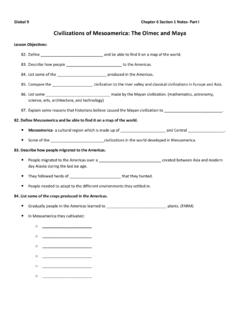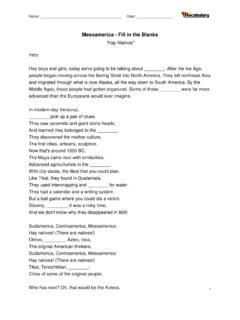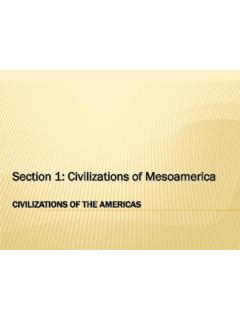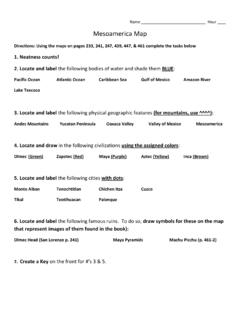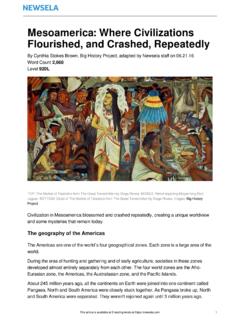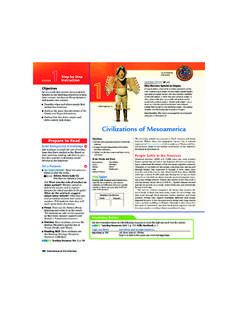Transcription of I. Early Societies of Mesoamerica A. The Olmecs
1 1. I. Early Societies of Mesoamerica A. The Olmecs 1. Asian Migration to Mesoamerica a. Humans traveled from Siberia to Alaska, 40,000 years ago, in search of big game b. By 7000 , reached the southern-most part of South America c. As hunting became difficult, agriculture began, 7500. 2. Early agriculture in Mesoamerica a. Beans, chili peppers, avocados, squashes, gourds were cultivated first b. By 5000 , discovered potential of maize, the staple food c. Later, developed tomatoes d. Agricultural villages appeared after 3000 e. No large animals, no wheeled vehicles 3. Ceremonial centers, by the end of the 2nd millennium 4. Olmecs : The "rubber people". a. Earliest center, on the coast of Mexico Gulf, 1400 b. Built by Olmecs , the "rubber people". c. Served as the capital for 400 years d. The other two later centers: La Venta and Tres Zapotes 5. Olmec society a.
2 Authoritarian in nature b. The colossal human heads - possibly likenesses of rulers (possibly African influence???). c. Rulers' power as shown in construction of huge pyramids 6. Trade in jade and obsidian 7. Decline and fall of Olmec society a. The cause remains a mystery b. The Olmecs systematically destroyed their ceremonial centers c. Most likely, civil conflict ruined their society d. By 400 , other Societies eclipsed the Olmecs 8. Influence of Olmec traditions a. Maize, ceremonial centers (closely tied) were common to later Societies b. Other legacies: Calendar, rituals of human sacrifice, ballgame c. Olmec did not leave written records (WE DON'T. THINK!!!). B. Heirs of the Olmecs :The Maya 1. The Maya a. Earliest heir of the Olmecs , lived in highlands of Guatemala b. Teotihuacan became dominant city-state during the 4th century (Maya were initially organized into city- states c.)
3 After the 4th century, society flourished in lowlands 2. d. Besides maize, also cultivated cotton and cacao (chocolate). 2. Tikal a. Most important Maya political center, 300 to 900 b. A bustling city of 40,000 people c. Enormous plazas, scores of temples, pyramids, palaces 3. Maya warfare a. Victorious warriors won enormous prestige b. War captives became slaves or sacrificial victims to gods 4. Chich n Itz . a. Rose as a power by the 9th century b. Organized a loose empire in the northern Yucatan 5. Maya decline a. Began in 800 , the Mayas (except in Chich n Itz ). deserted their cities (But, Mayans did not disappear!). b. Causes of decline remain unclear C. Maya Society and Religion 1. Maya society a. Kings, priests, and hereditary nobility at the top b. Merchants were from the ruling class, served also as ambassadors c. Professional architects and artisans were important d.
4 Peasants and slaves were majority of population 2. The Maya calendar a. Maya priests understood planetary cycles and could predict eclipses b. Besides the solar year (365 days), also had a ritual year of 260 days and 20 months c. Combined attributes of the two calendars determined the fortune of activities 3. Maya writing (one of only 5 independent written languages). 4. Contained both ideographic elements and symbols for syllables a. Maya scribes used writing extensively b. Only 4 books (Codices) survived the destruction by Spanish conquerors 5. Religious thought a. Popol Vuh, a Maya creation myth, taught that gods created humans out of maize and water b. Gods maintained agricultural cycles in exchange for honors and sacrifices 6. Bloodletting rituals a. The most important rituals, to honor the gods for rains b. Besides sacrificing captives, also voluntary bloodshedding 7.
5 The Maya ballgame Pok-a-tok a. Played by two individuals or two teams b. Very popular, every ceremonial center had stone-paved courts D. Other heirs of the Olmecs : Teotihuacan 1. The city of Teotihuacan a. Built in the highlands of Mexico 3. b. Colossal pyramids of sun and moon dominated the skyline c. High point between 400 and 600 , the city had 200,000 inhabitants (a nation within itself). d. Paintings and murals reflect the importance of priests 2. Teotihuacan society a. Rulers and priests dominated society b. Two-thirds of the city inhabitants worked in fields during daytime c. Artisans were famous for their obsidian tools and orange pottery d. Professional merchants traded extensively throughout Mesoamerica e. No sign of military organization or conquest (outside protection?). 3. Cultural traditions a. Inherited Olmecs ' culture: ballgame, calendar, writing, human sacrifices b.
6 Honored an earth god and a rain god 4. Decline of Teotihuacan a. Faced military pressure from other peoples since 500. b. Began to decline about 650 c. Invaders sacked and ruined the city, mid-8th century Societies of South America F. Early Andean Society and the Chav n cult 1. Early migration a. By 12,000 hunting and gathering peoples reached South America b. By 8000 began to experiment with agriculture c. Complex Societies appeared in central Andean region after 1000 d. Andean Societies located in modern day Peru and Bolivia e. Geography hindered communication between Andeans and Mesoamericans as well as within the Andean region 2. Early agriculture in South America a. Main crops: beans, peanuts, sweet potatoes, cotton b. Fishing supplemented agricultural harvests c. By 1800 , produced pottery, built temples and pyramids 3. The Chav n Cult a. Very popular around 900 to 800 , but vanished completely by about 300 b.
7 The rise of the cult was probably related to introduction of maize c. The cult left large temple complexes and elaborate art works 4. Complexity of Andean society a. Devised techniques of producing cotton textiles and fishing nets b. Discovered gold, silver, and copper metallurgy c. Cities began to appear shortly after Chav ncult 4. d. Early Andeans did not make use of writing G. Early Andean States: Mochica (300-700 ) The Moche 1. The Mochica state - one of several Early Andean states, located in northern Peru 2. Mochica ceramics: lives of different social classes 3. Like other Andean states, Mochica did not integrate the whole Andean region II. Early Society of Oceania A. Early Societies in Australia and New Guinea 1. Early migrations a. Human migrants arrived in Australia and New Guinea at least 60,000 years ago b. By the mid-centuries of the first millennium , human communities in all habitable islands of the Pacific Ocean c.
8 About 10,000 years ago, rising seas separated Australia and New Guinea d. Australia: hunting and gathering until the 19th and 20th centuries e. New Guinea: Turned to agriculture about 3000 2. Early hunting and gathering Societies in Australia a. Small communities, seasonal migrations for food b. Plant-based diet of the Australian peoples c. Animals and fish were also in their diet 3. Austronesian peoples a. From southeast Asia, spoke Austronesian languages b. Processed remarkable seafaring skills c. Settled in north New Guinea, 3000 4. Early agriculture in New Guinea a. Austronesians introduced root crops and herding animals b. Indigenous peoples soon began to cultivate crops and keep animals c. Agriculture brought population growth and specialization B. The Peopling of the Pacific Islands 1. Austronesian migration to Polynesia (Polynesian People). a. Outrigger canoes enabled them to sail safely b.
9 Agriculture and domesticated animals helped them to settle in new-found islands 2. Austronesian migrations to Micronesia and Madagascar a. Early agriculture in the resource-poor Pacific islands b. Chiefly political organization 1. Strong chiefly Societies found on large islands - Tonga, Samoa, Hawaii 2. Chiefs and their retinues claimed a portion of agricultural surplus 3. Oversaw irrigation systems, public rituals 4. Chiefs and aristocrats regarded themselves as divine or semidivine 5. Mesoamerica - Region from the central portion of GLOSSARY modern Mexico to Honduras and El Salvador. Austronesians) - Seafaring peoples from southeast Mochica Ceramics - Painted pottery vessels of the Asia who first entered New Guinea and surrounding Mochican people of the Andean region; contained islands about 5,000 years ago. Their skills of detailed and expressive depictions of Early Andean navigation, agriculture, and raising domestic animals society in all its variety.
10 Helped them to people most islands of the Pacific. Mochica - One of the Andean states, located in the bloodletting rituals - Rituals practiced by Mayans with valley of the Moche River; dominated the coasts and the belief that such sacrifices would please the gods valleys of northern Peru during the period from about who, in turn, would send rain to sustain agriculture. 300 to 700 cacao - Large beans first cultivated by the Mayans, Oceania - Designation refers to most of the islands in which were the source of chocolate. Cacao was a the Pacific Ocean; subdivisions include Melanesia, precious commodity consumed mostly by nobles in Micronesia, Polynesia, Australia and New Zealand. Mayan society, and cacao beans were also used as money. Olmecs - First complex society of the Americas, with its center located on the coast of the Gulf of Mexico, near Chav n cult - Popular religious cult of the Andeans, the modern Mexican city of Veracruz; cultural traditions centered at the modern location of Chav n de Huantar influenced all complex Societies of Mesoamerica until in northern Peru.
